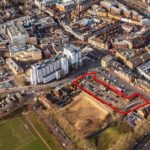The following was written by Sam Hollingworth, associate director of planning at Savills’ Chelmsford office.
Sir Keir Starmer recently announced a Labour government would give local authorities in England greater power to allow houses to be built in the Green Belt as part of measures to boost housing supply and enable more people to own their home.
Any move to loosen the protection of the Green Belt would be a significant departure from the approach taken by successive governments – holding, as it does, a powerful position in the public consciousness associated with safeguarding the best of our ‘green and pleasant land’.
However, in reality, other policies and designations – Areas of Outstanding Natural Beauty (AONB) and Sites of Special Scientific Interest (SSSI) – perform this important role. Green Belt land varies in character and can include pockets of scrubland, grazing land, woodland and equally derelict buildings, runways and even existing small villages.
During his speech Sir Kier offered an example of where the inflexible application of policy resulted in a playing field in Maidstone (outside of the Green Belt) being developed for housing ahead of a car park (within the Green Belt). Such seemingly perverse outcomes have led some in the industry to question whether such a rigid interpretation actually results in more sustainable patterns of development – a key objective of the planning system.
Our own research has shown that many areas constrained by Green Belt are those with the highest levels of housing need, but with poorest records of delivery – supporting the case that policy designation is a significant barrier to addressing housing requirements.
The introduction of the government’s Housing Delivery Test (HDT) – which measures housing delivery relative to housing requirements – has provided an objective method of comparing the record of local authorities. Of the 20 worst-performing local authorities in 2021, a disproportionate number (15) were local authorities containing Green Belt.
Additionally, the majority of the 51 local authorities whose 2021 HDT measurements were below 75 per cent (a performance considered so low as to trigger a ‘presumption in favour of sustainable development’) were authorities that contain Green Belt.
Here in the East, Essex provides an interesting example. The area has strong connections to London and is subject to significant local housing needs.
The south of the county is largely constrained by Green Belt, and its authorities have some of the worst housing delivery records in the country. Conversely, mid and north Essex (which contains much countryside but no Green Belt) has seen a significantly greater proportion of its housing requirements met in recent years.
Whilst statisticians will warn against confusing correlation with causation, the marked contrast between the performance of so-called ‘Green Belt authorities’ and those that contain no Green Belt supports the case that the policy designation is a significant barrier to addressing housing needs.
Of course, we need planning policies that protect important habitats and attractive landscapes, but other policies and allocations perform this role. Since its inception, the Green Belt has largely achieved its objectives of keeping certain land open and avoiding the coalescence of settlements within it.
But Sir Kier’s playing field/car park example demonstrates some of its pitfalls. An obvious question for any government is whether the policy in its current form is really helping to address the challenges we face today.
Given the powerful hold that Green Belt has on the public consciousness, this will doubtless prove a challenging issue for any future government to address.
We can perhaps expect further policy announcements before (and after) the General Election, but as recent history shows, these are not easy or quick matters to resolve.
© Eastern Echo (powered by ukpropertyforums.com).
Sign up to receive our weekly free journal, The Forum here.
















